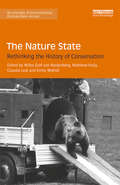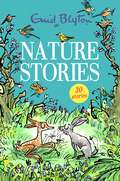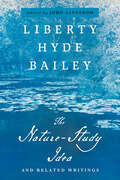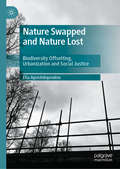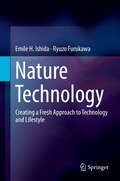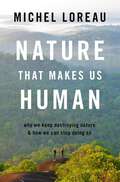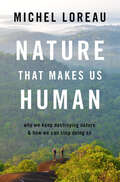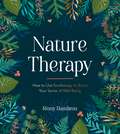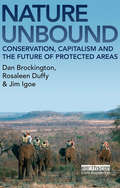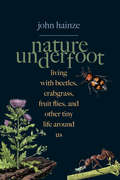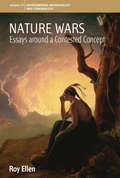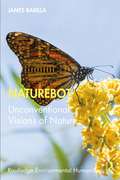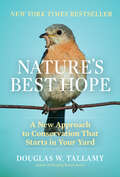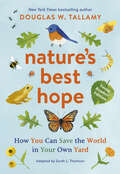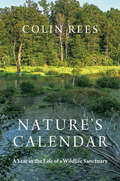- Table View
- List View
The Nature State: Rethinking the History of Conservation (Routledge Environmental Humanities)
by Wilko Graf Von Hardenberg Matthew Kelly Claudia Leal Emily WakildThis volume brings together case studies from around the globe (including China, Latin America, the Philippines, Namibia, India and Europe) to explore the history of nature conservation in the twentieth century. It seeks to highlight the state, a central actor in these efforts, which is often taken for granted, and establishes a novel concept – the nature state – as a means for exploring the historical formation of that portion of the state dedicated to managing and protecting nature. Following the Industrial Revolution and post-war exponential increase in human population and consumption, conservation in myriad forms has been one particularly visible way in which the government and its agencies have tried to control, manage or produce nature for reasons other than raw exploitation. Using an interdisciplinary approach and including case studies from across the globe, this edited collection brings together geographers, sociologists, anthropologists and historians in order to examine the degree to which sociopolitical regimes facilitate and shape the emergence and development of nature states. This innovative work marks an early intervention in the tentative turn towards the state in environmental history and will be of great interest to students and practitioners of environmental history, social anthropology and conservation studies.
The Nature State: Rethinking the History of Conservation (Routledge Environmental Humanities)
by Wilko Graf von Hardenberg Matthew Kelly Claudia Leal Emily WakildThis volume brings together case studies from around the globe (including China, Latin America, the Philippines, Namibia, India and Europe) to explore the history of nature conservation in the twentieth century. It seeks to highlight the state, a central actor in these efforts, which is often taken for granted, and establishes a novel concept – the nature state – as a means for exploring the historical formation of that portion of the state dedicated to managing and protecting nature. Following the Industrial Revolution and post-war exponential increase in human population and consumption, conservation in myriad forms has been one particularly visible way in which the government and its agencies have tried to control, manage or produce nature for reasons other than raw exploitation. Using an interdisciplinary approach and including case studies from across the globe, this edited collection brings together geographers, sociologists, anthropologists and historians in order to examine the degree to which sociopolitical regimes facilitate and shape the emergence and development of nature states. This innovative work marks an early intervention in the tentative turn towards the state in environmental history and will be of great interest to students and practitioners of environmental history, social anthropology and conservation studies.
Nature Stories: Contains 30 classic tales (Bumper Short Story Collections)
by Enid BlytonA collection of thirty wonderful stories about the nature and the countryside from one of the world's best-loved children's authors.Enjoy the freedom of the outdoors, the beauty of the countryside and the charm of all creatures great and small in this bumper short-story collection. Enid Blyton loved the countryside, animals and birds and she wrote many wonderful stories to teach children all about the natural world. Each story is perfect for reading aloud to young children and is the ideal length for bedtime or classroom story time.***Enid Blyton ® and Enid Blyton's signature are Registered Trademarks of Hodder & Stoughton Limited. No trademark or copyrighted material may be reproduced without the express written permission of the trademark and copyright owner.
The Nature-Study Idea: And Related Writings (The Liberty Hyde Bailey Library)
by Liberty Hyde BaileyIn The Nature-Study Idea, Liberty Hyde Bailey articulated the essence of a social movement, led by ordinary public-school teachers, that lifted education out of the classroom and placed it into firsthand contact with the natural world. The aim was simple but revolutionary: sympathy with nature to increase the joy of living and foster stewardship of the earth.With this definitive edition, John Linstrom reintroduces The Nature-Study Idea as an environmental classic for our time. It provides historical context through a wealth of related writings, and introductory essays relate Bailey's vision to current work in education and the intersection of climate change and culture. In this period of planetary turmoil, Bailey's ambition to cultivate wonder (in adults as well as children) and lead readers back into the natural world is more important than ever.
Nature Swapped and Nature Lost: Biodiversity Offsetting, Urbanization and Social Justice
by Elia ApostolopoulouThis book unravels the profound implications of biodiversity offsetting for nature-society relationships and its links to environmental and social inequality. Drawing on people’s resistance against its implementation in several urban and rural places across England, it explores how the production of equivalent natures, the core promise of offsetting, reframes socionatures both discursively and materially transforming places and livelihoods.The book draws on theories and concepts from human geography, political ecology, and Marxist political economy, and aims to shift the trajectory of the current literature on the interplay between offsetting, urbanization and the neoliberal reconstruction of conservation and planning policies in the era following the 2008 financial crash. By shedding light on offsetting’s contested geographies, it offers a fundamental retheorization of offsetting capable of demonstrating how offsetting, and more broadly revanchist neoliberal policies, are increasingly used to support capitalist urban growth producing socially, environmentally and geographically uneven outcomes. Nature Swapped and Nature Lost brings forward an understanding of environmental politics as class politics and sees environmental justice as inextricably linked to social justice. It effectively challenges the dystopia of offsetting’s ahistorical and asocial non-places and proposes a radically different pathway for gaining social control over the production of nature by linking struggles for the right to the city with struggles for the right to nature for all.
Nature Technology: Creating a Fresh Approach to Technology and Lifestyle
by Emile H. Ishida Ryuzo FurukawaThe Great East Japan Earthquake, which occurred on March 11, 2011, reminded us that we were just one species within the great cycle of life on earth, that we were allowed to survive only because of nature, and that the idea that we were somehow able to conquer nature was simply an illusion. Now more than ever it is time that we confront head-on the change from the "underground resources" type of civilization to one with a new way of life and technology that embraces a sense of nature. To do so, we must learn from nature, the only sustainable society on earth, and create technology that embraces such a view of nature. We call such technology, which cleverly revives nature's greatness, Nature Technology. Taking a casual glance at nature, a nest of termites in the savanna region can be observed to maintain a steady temperature of 30°C despite the fact that the outside air temperature ranges from 50°C during the day to nearly 0°C at night. There are countless numbers of open pores just several billionths of a meter (nanometer) wide in the "earth" of the nest, which serve to regulate the temperature and humidity. In fact, all kinds of "earth" have these pores (clay mineral with aggregated structures) and air conditioners that require no electricity have been created by hardening this earth while preserving its structure; a cooling floor or wall becomes the alternative to a conventional air conditioner. This book provides many such examples of how Nature Technology can support a new lifestyle that is both environmentally sound and spiritually uplifting.
Nature That Makes Us Human: Why We Keep Destroying Nature and How We Can Stop Doing So
by Michel LoreauClimate change, biodiversity loss, pollution, resource depletion, new emerging diseases: scientists have raised awareness on the ecological and societal consequences of the unbridled development of human activities for a long time. Why do we keep destroying nature when science makes it clear that in doing so we risk our own destruction? How can we stop destroying our life-support system and reach some kind of harmony between humans and nature? This book seeks to answer these questions. It describes the inability of modern society to fundamentally modify its relationship with nature, instead engaging in collective fictions such as subject-object duality, matter-mind duality, the primacy of rationality, and the superiority of the human species over all other life. Subsequent chapters identify avenues which could allow human societies to break the current deadlock and forge a relationship with the natural world. This path is rooted in a simple observation: humans have a nature that defines them as a unique species beyond their cultural differences, and at the foundation of this nature we share a set of fundamental needs. The expression and satisfaction of these needs provide an opportunity to reconnect humans with nature in all its forms. Nature That Makes Us Human combines recent scientific discoveries in biology and psychology with deep philosophical inquiry--in addition to economic, political, and historical considerations--to understand what motivates us to keep destroying nature today and how we can engage in a new relationship with nature tomorrow. This book is for anyone interested in understanding and overcoming the current ecological crisis.
Nature That Makes Us Human: Why We Keep Destroying Nature and How We Can Stop Doing So
by Michel LoreauClimate change, biodiversity loss, pollution, resource depletion, new emerging diseases: scientists have raised awareness on the ecological and societal consequences of the unbridled development of human activities for a long time. Why do we keep destroying nature when science makes it clear that in doing so we risk our own destruction? How can we stop destroying our life-support system and reach some kind of harmony between humans and nature? This book seeks to answer these questions. It describes the inability of modern society to fundamentally modify its relationship with nature, instead engaging in collective fictions such as subject-object duality, matter-mind duality, the primacy of rationality, and the superiority of the human species over all other life. Subsequent chapters identify avenues which could allow human societies to break the current deadlock and forge a relationship with the natural world. This path is rooted in a simple observation: humans have a nature that defines them as a unique species beyond their cultural differences, and at the foundation of this nature we share a set of fundamental needs. The expression and satisfaction of these needs provide an opportunity to reconnect humans with nature in all its forms. Nature That Makes Us Human combines recent scientific discoveries in biology and psychology with deep philosophical inquiry--in addition to economic, political, and historical considerations--to understand what motivates us to keep destroying nature today and how we can engage in a new relationship with nature tomorrow. This book is for anyone interested in understanding and overcoming the current ecological crisis.
Nature Therapy: How to Use Ecotherapy to Boost Your Sense of Well-Being
by Rémy DambronNature therapy is the practice of reconnecting with the natural world to refresh your physical and mental well-being. Including tips to help you discover your connection with the outdoors, activity inspiration and a holistic approach to wellness, this book is the ultimate guide to unlocking the transformative power of nature.
Nature Unbound: "Conservation, Capitalism and the Future of Protected Areas"
by Dan Brockington Rosaleen Duffy Jim IgoeThis groundbreaking volume is the first comprehensive, critical examination of the rise of protected areas and their current social and economic position in our world. It examines the social impacts of protected areas, the conflicts that surround them, the alternatives to them and the conceptual categories they impose. The book explores key debates on devolution, participation and democracy; the role and uniqueness of indigenous peoples and other local communities; institutions and resource management; hegemony, myth and symbolic power in conservation success stories; tourism, poverty and conservation; and the transformation of social and material relations which community conservation entails. For conservation practitioners and protected area professionals not accustomed to criticisms of their work, or students new to this complex field, the book will provide an understanding of the history and current state of affairs in the rise of protected areas. It introduces the concepts, theories and writers on which critiques of conservation have been built, and provides the means by which practitioners can understand problems with which they are wrestling. For advanced researchers the book will present a critique of the current debates on protected areas and provide a host of jumping off points for an array of research avenues
Nature Unbound: "Conservation, Capitalism and the Future of Protected Areas"
by Dan Brockington Rosaleen Duffy Jim IgoeThis groundbreaking volume is the first comprehensive, critical examination of the rise of protected areas and their current social and economic position in our world. It examines the social impacts of protected areas, the conflicts that surround them, the alternatives to them and the conceptual categories they impose. The book explores key debates on devolution, participation and democracy; the role and uniqueness of indigenous peoples and other local communities; institutions and resource management; hegemony, myth and symbolic power in conservation success stories; tourism, poverty and conservation; and the transformation of social and material relations which community conservation entails. For conservation practitioners and protected area professionals not accustomed to criticisms of their work, or students new to this complex field, the book will provide an understanding of the history and current state of affairs in the rise of protected areas. It introduces the concepts, theories and writers on which critiques of conservation have been built, and provides the means by which practitioners can understand problems with which they are wrestling. For advanced researchers the book will present a critique of the current debates on protected areas and provide a host of jumping off points for an array of research avenues
Nature Underfoot: Living with Beetles, Crabgrass, Fruit Flies, and Other Tiny Life Around Us
by John HainzeAn informed and heartfelt tribute to commonly unappreciated plants, insects, and other tiny creatures that reconsiders humanity’s relationship to nature Fruit flies, silverfish, dandelions, and crabgrass are the bane of many people and the target of numerous chemical and physical eradication efforts. In this compelling reassessment of the relationship between humans and the natural world, John Hainze—an entomologist and former pesticide developer—considers the fascinating and bizarre history of how these so-called invasive or unwanted pests and weeds have coevolved with humanity and highlights the benefits of a greater respect and moral consideration toward these organisms. With deep insight into the lives of the underappreciated and often reviled creatures that surround us, Hainze’s accessible and engaging natural history draws on ethics, religion, and philosophy as he passionately argues that creepy crawlies and unwanted plants deserve both empathy and accommodation as partners dwelling with us on earth.
Nature, Value, Duty: Life on Earth with Holmes Rolston, III (The International Library of Environmental, Agricultural and Food Ethics #8)
by Christopher J. Preston Wayne OuderkirkThis is a collection of contemporary writings on the work of Holmes Rolston, III. The authors contributing to this volume are a mixture of senior scholars in environmental ethics and new voices in philosophy and in literature. Together they provide an in depth evaluation of many of the topics discussed by Rolston. Rolston himself, in a detailed reply to each of his critics at the end of the volume, reveals where some of these criticisms sting him the most.
Nature Wars: Essays Around a Contested Concept (Environmental Anthropology and Ethnobiology #27)
by Roy EllenOrganized around issues, debates and discussions concerning the various ways in which the concept of nature has been used, this book looks at how the term has been endlessly deconstructed and reclaimed, as reflected in anthropological, scientific, and similar writing over the last several decades. Made up of ten of Roy Ellen’s finest articles, this book looks back at his ideas about nature and includes a new introduction that contextualizes the arguments and takes them forward. Many of the chapters focus on research the author has conducted amongst the Nuaulu people of eastern Indonesia.
Naturebot: Unconventional Visions of Nature (Routledge Environmental Humanities)
by James BarillaNaturebot: Unconventional Visions of Nature presents a humanities-oriented addition to the literature on biomimetics and bioinspiration, an interdisciplinary field which investigates what it means to mimic nature with technology. This technology mirrors the biodiversity of nature and it is precisely this creation of technological metaphors for the intricate workings of the natural world that is the real subject of Naturebot. Over the course of the book, Barilla applies the narrative conventions of the nature writing genre to this unconventional vision of nature, contrasting the traditional tropes and questions of natural history with an expanding menagerie of creatures that defy conventional categories of natural and artificial. In keeping with its nature writing approach, the book takes us to where we can encounter these creatures, examining the technological models and the biotic specimens that inspired them. In doing so, it contemplates the future of the human relationship to the environment, and the future of nature writing in the 21st century. This book will be of great interest to students and scholars of biomimetics, environmental literary studies/ecocriticism, and the environmental humanities.
Naturebot: Unconventional Visions of Nature (Routledge Environmental Humanities)
by James BarillaNaturebot: Unconventional Visions of Nature presents a humanities-oriented addition to the literature on biomimetics and bioinspiration, an interdisciplinary field which investigates what it means to mimic nature with technology. This technology mirrors the biodiversity of nature and it is precisely this creation of technological metaphors for the intricate workings of the natural world that is the real subject of Naturebot. Over the course of the book, Barilla applies the narrative conventions of the nature writing genre to this unconventional vision of nature, contrasting the traditional tropes and questions of natural history with an expanding menagerie of creatures that defy conventional categories of natural and artificial. In keeping with its nature writing approach, the book takes us to where we can encounter these creatures, examining the technological models and the biotic specimens that inspired them. In doing so, it contemplates the future of the human relationship to the environment, and the future of nature writing in the 21st century. This book will be of great interest to students and scholars of biomimetics, environmental literary studies/ecocriticism, and the environmental humanities.
Nature's Allies: Eight Conservationists Who Changed Our World
by Larry NielsenIt’s easy to feel powerless in the face of big environmental challenges—but we need inspiration more than ever. With political leaders who deny climate change, species that are fighting for their very survival, and the planet’s last places of wilderness growing smaller and smaller, what can a single person do? In Nature’s Allies, Larry Nielsen uses the stories of conservation pioneers to show that through passion and perseverance, we can each be a positive force for change. In eight engaging and diverse biographies—John Muir, Ding Darling, Aldo Leopold, Rachel Carson, Chico Mendes, Billy Frank Jr., Wangari Maathai, and Gro Harlem Brundtland—we meet individuals who have little in common except that they all made a lasting mark on our world. Some famous and some little known to readers, they spoke out to protect wilderness, wildlife, fisheries, rainforests, and wetlands. They fought for social justice and exposed polluting practices. They marched, wrote books, testified before Congress, performed acts of civil disobedience, and, in one case, were martyred for their defense of nature. Nature’s Allies pays tribute to them all as it rallies a new generation of conservationists to follow in their footsteps. These vivid biographies are essential reading for anyone who wants to fight for the environment against today’s political opposition. Nature’s Allies will inspire students, conservationists, and nature lovers to speak up for nature and show the power of one person to make a difference.
Nature's Best Hope: A New Approach to Conservation That Starts in Your Yard
by Douglas W. TallamyAn urgent and heartfelt call for a new approach to conservation—one that starts in every backyard—from the New York Times bestselling author of Bringing Nature Home.
Nature's Best Hope (Young Readers' Edition): How You Can Save the World in Your Own Yard
by Douglas W. TallamyThis middle grade edition of the groundbreaking bestseller by Doug Tallamy will inspire kids to use their backyard to help save the planet. Douglas W. Tallamy awakened thousands of readers to an urgent situation: wildlife populations are in decline because the native plants they depend on are fast disappearing. His solution? Plant more natives. In this middle grade adaptation of the New York Times bestseller Nature's Best Hope, Tallamy outlines his vision for a grassroots approach to conservation that everyone can participate in regardless of age. In Nature's Best Hope (Young Readers' Edition), Tallamy empowers kids to use their own yards to help combat the negative effects of climate change. He does so by breaking down complex concepts into simple terms and real-world examples that kids can easily grasp. Black and white photographs help further clarify concepts. In addition to sharing the science, Tallamy encourages kids to take direct action. Some of these ideas include planting an oak tree (one of the most important tree species) at home. If that&’s too large of a task, he suggests they can plant asters—a beautiful flower whose pollen bees use to feed their young. By helping the next generation see that they have power and agency over our collective future, this empowering book will drive home the positive point that kids are truly nature&’s best hope.
Nature's Blessings
by Kirsten RiddleBe inspired by the wonderful world of nature through intentions, practical exercises and meditations for greater wellbeing and joy. We are always looking for ways to reconnect with nature. The benefits of spending time outdoors include engaging our senses and experiencing the landscape at a deeper level – but it’s not so easy to rewild and run free when we have chores and responsibilities. That’s where Nature’s Blessings can help. Kirsten Riddle will help you shift your perspective, engage with the environment and learn more about the natural world. She looks at a range of aspects of nature, from trees to rivers, sunlight to storms, butterflies to otters, and highlights ideas and positive lessons associated with each one. Arranged by the four elements, there are overall themes throughout the book: Earth is about grounding and balance; Air is about inspiration and freedom; Fire is connected to confidence and passion; Water concerns healing and self-expression. Each entry includes a daily intention, associated folklore, practical exercises to try and a closing meditation. With tips and suggestions on how you can connect with nature and the intentions at different stages during your day, you will soon be able to welcome all the blessings of nature into your life.
Nature's Burdens: Conservation and American Politics, The Reagan Era to the Present
by Daniel NelsonNature’s Burdens is a political and intellectual history of American natural resource conservation from the 1980s into the twenty-first century—a period of intense political turmoil, shifting priorities among federal policymakers, and changing ideas about the goals of conservation. Telling a story of persistent activism, conflict, and frustration but also of striking achievement, it is an account of how new ideas and policies regarding human relationships to plants, animals, and their surroundings have become vital features of modern environmentalism. In the 1960s and 1970s, Congress embraced the largely dormant movement to preserve distinctive landscapes and the growing demand for outdoor recreation, establishing an unprecedented number of parks, monuments, and recreation areas. The election of Ronald Reagan and a shift to a Republican-controlled Senate brought this activity to an abrupt halt and introduced a period of intense partisanship and legislative gridlock that extends to the present. In this political climate, three developments largely defined the role of conservation in contemporary society: environmental organizations have struggled to defend the legal status quo, private land conservation has become increasingly important, and the emergence of potent scientific voices has promoted the protection of animals and plants and injected a new sense of urgency into the larger cause. These developments mark this period as a distinctive and important chapter in the history of American conservation. Scrupulously researched, scientifically and politically well informed, concise, and accessibly written, Nature’s Burdens is the most comprehensive examination of recent efforts to protect and enhance the natural world. It will be of interest to environmental historians, environmental activists, and any general reader interested in conservation.
Nature's Calendar: A Year in the Life of a Wildlife Sanctuary
by Colin ReesFlocks of waterfowl exploding into steely skies above frozen marshland, salamanders creeping across the forest floor to vernal pools, chorusing frogs peeping their ecstasy while warblers crowd budding trees, turtles sunning on floating logs, the ecological engineering of beavers;¢;‚¬;€?these are but a few of the sights and sounds marking a year at Jug Bay Wetlands Sanctuary and its neighboring landscapes in Southern Maryland. In an absorbing account of a year in the life of this sanctuary, naturalist Colin Rees invites us to join him as he explores the secrets and wonders of the changing natural world. Alongside the author, we witness spring's avian migrations, quickening of aquatic vegetation, burgeoning of myriad invertebrates, and the assaults of extreme weather conditions. We revel in summertime's proliferation of fish, fowl, and mammals. We become attuned to the shifting climate's impacts on autumnal transitions, and we marvel at amazing feats of biological inventiveness in preparation for winter conditions. Through these visions of the fleeting;¢;‚¬;€?and yet enduring;¢;‚¬;€?cycles of nature, Rees shares deep insights into the ecological and behavioral dynamics of the natural environment. Enhanced by more than two dozen color plates, the book touches on a wide range of issues, from microbial diversity, bird banding, and butterfly phenology to genetic diversity and habitat fragmentation. It also examines the challenges of conserving these and other natural features in the face of climate change and development pressures. Thoughtful and lyrical, Nature's Calendar speaks to all readers, scientific and lay alike. Fascinating profiles of flora and fauna celebrate the richness and complexity of a unique ecosystem, exploring the entire ecology of this dynamic and delicate area.
Nature's Calendar: A Year in the Life of a Wildlife Sanctuary
by Colin ReesFlocks of waterfowl exploding into steely skies above frozen marshland, salamanders creeping across the forest floor to vernal pools, chorusing frogs peeping their ecstasy while warblers crowd budding trees, turtles sunning on floating logs, the ecological engineering of beavers;¢;‚¬;€?these are but a few of the sights and sounds marking a year at Jug Bay Wetlands Sanctuary and its neighboring landscapes in Southern Maryland. In an absorbing account of a year in the life of this sanctuary, naturalist Colin Rees invites us to join him as he explores the secrets and wonders of the changing natural world. Alongside the author, we witness spring's avian migrations, quickening of aquatic vegetation, burgeoning of myriad invertebrates, and the assaults of extreme weather conditions. We revel in summertime's proliferation of fish, fowl, and mammals. We become attuned to the shifting climate's impacts on autumnal transitions, and we marvel at amazing feats of biological inventiveness in preparation for winter conditions. Through these visions of the fleeting;¢;‚¬;€?and yet enduring;¢;‚¬;€?cycles of nature, Rees shares deep insights into the ecological and behavioral dynamics of the natural environment. Enhanced by more than two dozen color plates, the book touches on a wide range of issues, from microbial diversity, bird banding, and butterfly phenology to genetic diversity and habitat fragmentation. It also examines the challenges of conserving these and other natural features in the face of climate change and development pressures. Thoughtful and lyrical, Nature's Calendar speaks to all readers, scientific and lay alike. Fascinating profiles of flora and fauna celebrate the richness and complexity of a unique ecosystem, exploring the entire ecology of this dynamic and delicate area.
Nature's Chaos
by James GleickWith 102 spectacular full-color photos, this fascinating "field guide" explores the world's natural disorder.
Nature's Child
by Sir John Lister-KayeAs I write Hermione's twelfth year is drawing to a close. The years of innocence are waning. But we have had the good fortune to live through a period when a child's mind is wide open and as absorbent as a sponge. Blessed years of exploration and discovery, fat and full of the natural world, which surrounds her here ... the mountains and forests and ospreys, eagles, otters and pine martens of a beautiful land.' NATURE'S CHILD is John Lister-Kaye's account of bringing up his daughter to appreciate the nature around her so beloved to himself. It is also a moving meditation on that world, and on their relationship, as he shows her how caterpillars metamorphose into moths; how beavers build dams in Norway; how half a million sea birds migrate to Shetland once a year to breed; how white rhinos behave in the wilds of Swaziland; how baby polar bears are raised on an archipelago in the Arctic Ocean. As John puts it: 'Life is a collection of fragments of time charged with deeply personal sensation and meaning ... we had watched polar bears for a few minutes, but the recollection of those images are locked in for life. What is love if not time given in joy and delight?
